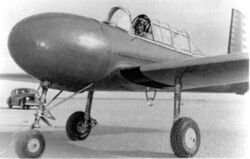Engineering:Fletcher FBT-2
| FBT-2 | |
|---|---|
| Role | Trainer |
| Manufacturer | Fletcher Aviation |
| Designer | Wendell Fletcher |
| First flight | 1941 |
| Primary user | United States Army Air Forces |
| Number built | 1 (and 10 airframes converted to glide bombs) |
| Variants | Fletcher BG-2 |
The Fletcher FBT-2 was a military trainer aircraft built in the United States in the early 1940s. Although it was never entered production as a trainer, it was ordered in small numbers as a target drone but when that was cancelled played a small part in the development of guided bombs.
Design and development
The FBT-2 was a low-wing cantilever monoplane with fixed tailwheel undercarriage which seated the pilot and instructor in tandem in an enclosed cockpit. Construction throughout was of plywood, and the wings were interchangeable, as were the tail panels.[1]
Operational history
A single prototype was evaluated for military use, but generated no interest. However, the USAAF ordered the type as a radio-controlled target drone under the designation XPQ-11. The prototype FBT-2 was modified for use as a drone controller as the YCQ-1A. Two batches of 50 drones were ordered; however before any were delivered, the type was cancelled in favor of the PQ-8 Cadet, only the single prototype XPQ-11 being completed.[2] The Army then ordered the ten PQ-11s under construction to be completed as XBG-1 glide bombs, the engine being removed and replaced with a 2,000-pound (910 kg) bomb.[3] Testing was conducted, but the type failed to enter operational service.[4]
Variants
- FBT-2 - basic trainer with Wright R-760 engine and tailwheel undercarriage (1 built)
- CQ-1 - drone controller with tricycle undercarriage (1 converted from FBT-2)
- PQ-11 - aerial target with tricycle undercarriage and Pratt & Whitney R-985 engine (contract cancelled before aircraft completed)
- BG-1 - glide bomb with 2,000-pound (910 kg) warhead (10 built from unfinished PQ-11s)
Operators
 United States
United States
Specifications (FBT-2)
Data from Taylor[5]
General characteristics
- Crew: 1 (pilot; optional)
- Length: 23 ft 3 in (7.09 m)
- Wingspan: 30 ft (9.1 m)
- Height: 10 ft 5 in (3.18 m)
- Powerplant: 1 × Wright R-760-E2 Whirlwind radial engine, 285 hp (213 kW)
Performance
- Maximum speed: 175 mph (282 km/h, 152 kn)
- Range: 540 mi (870 km, 470 nmi)
- Service ceiling: 19,000 ft (5,800 m)
Armament
- None in FBT-2 or PQ-11
- XBG-1: 2,000-pound (910 kg) warhead.
See also
Aircraft of comparable role, configuration and era
- Pratt-Read LBE
- Piper LBP
- Taylorcraft LBT
Related lists
- List of military aircraft of the United States
- List of unmanned aerial vehicles
References
Citations
Bibliography
- Bridgman, Leonard (1956). Jane's All the World's Aircraft 1956-1957. London: Sampson Low, Marston & Company.
- Parsch, Andreas (25 June 2009). "BG Series (BG-1 through BG-3)". Directory of U.S. Military Rockets and Missiles, Appendix 1: Early Missiles and Drones. Designation-Systems. http://www.designation-systems.net/dusrm/app1/bg.html.
- Parsch, Andreas (7 February 2012). "PQ Series (PQ-8 through PQ-15)". Directory of U.S. Military Rockets and Missiles, Appendix 1: Early Missiles and Drones. Designation-Systems. http://www.designation-systems.net/dusrm/app1/pq.html#_PQ11.
- Taylor, Michael J. H. (1989). Jane's Encyclopedia of Aviation. New York: Portland House. ISBN 978-0517691861.
 |


